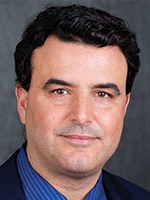October 2023—Hematology analyzers and the related workflow, expertise, efficiency, and IT matters were the topic of a roundtable when CAP TODAY publisher Bob McGonnagle met online Aug. 29 with two pathologists and representatives from Horiba, Siemens, Sysmex, CellaVision, Sight, and Abbott. Their conversation follows. Click here for CAP TODAY’s guide to hematology analyzers.

Dr. Chaves
Fernando Chaves, what are the advances in artificial intelligence in the field of hematology, particularly automated hematology, since we spoke during our roundtable at this time last year?
Fernando Chaves, MD, global head of hematology, Siemens Healthineers: Technology now enables full-field digital morphology, a full image of the entire slide scan. Now we can do with hematology what has been done for over a decade in surgical pathology. It brings benefits to customers because it not only preclassifies cells and facilitates the technologist’s work but also enables full remote consultation.
Having digital images under a full slide context creates an opportunity for clinical innovations. It’s already happening with applications for reviewing bone marrows and interpreting morphological abnormalities in the blood, and it could also be done in the future through automation and artificial intelligence solutions. Some of the sepsis parameters that are based on hematology are primarily morphologic parameters that are identified through a histogram. Now we have more sensitive technology that can identify abnormalities such as granularity of cells and heterogeneity of volume. All of that is because images are now digital and can be quantitatively analyzed through artificial intelligence image analysis algorithms.
Jonathan Galeotti, for years we’ve hypothesized that there’s more to be learned from studying the cells than we’ve been able to realize. Now we seem to be on the brink of breaking through in several important areas. Fernando mentioned sepsis but there’s also a plethora of hematologic malignancies that we may be able to understand better. How are you dealing with this at the clinical level in your institution at Chapel Hill?
Jonathan Galeotti, MD, clinical assistant professor, Department of Pathology and Laboratory Medicine, Division of Hematopathology, University of North Carolina School of Medicine: As the field moves forward, it takes a little time for it to work its way through academic labs and into clinical practice. We’re on the front end and have not yet incorporated it much into our hematology practice. There is certainly a need—we still have staffing issues. Anything you can do to streamline the process, to make review and autoverification easier, is on our minds all the time. Hope is there, but we haven’t realized it yet.
Tim Skelton, a lot of this requires a healthy IT backbone. Tell us how the IT environment at Beth Israel Lahey Health is being either friendly or frustrating as you look to bring in these latest applications in hematology.
Timothy Skelton, MD, PhD, medical director, core laboratory and clinical informatics, Lahey Hospital and Medical Center, and medical director, laboratory and pathology informatics, Beth Israel Lahey Health: We’re a 13-hospital system and we’re all standardizing to a single electronic health record. We’re struggling with where some of these algorithms should live. It’s a little different than the hype about artificial intelligence; we’ve been focusing on incorporating expertise. We do that by building into the algorithms within our IT systems the knowledge of our best hematology medical technologists. We’re doing this so that on the off-shift at a remote community hospital or a hematology-oncology lab, for example, the information based on this knowledge pops up for a technologist who may be a traveler or isn’t that experienced and tells them what the findings are, interprets the findings, and informs them of the actions to take. The middleware, instrument IPU [infrastructure processing unit], electronic health record—all are advancing quickly, so we’re always working to determine in which IT system we want to build a certain logic.
We use the CellaVision system, so pathologists or experts in the central lab can remote in and interpret if there’s a question. Having digital images is better than glass slides. We’re not doing anything with full slide imaging in hematology.

Dunbar
Scott Dunbar, it seems as though hematology is going the route of surgical pathology; that is to say, having the ability to remotely view specimens by experts who may be miles away. Do you see that evolution?
Scott Dunbar, director, Americas, CellaVision: More and more people have been buying remote review licenses. A lot of large systems have a hub-and-spoke model where there’s a mothership hospital and five to 10 satellite locations and a centralized database server that IT staff can control and lock down so things are encrypted appropriately. But we have pathologists and senior medical technologists remote reviewing into smaller hospitals where there isn’t the expertise. We see more people using remote review to improve turnaround times, centralize expertise, and standardize the most subjective area of the laboratory. We won’t argue over an 87 glucose on a standard curve in a spectrophotometer, but we could argue all day over what a monocyte in a reactive lymph is. How do you get that expertise? It’s a combination of the artificial intelligence we’ve been discussing here and having qualified morphologists.
Ihab Zidan, what are you doing at Abbott to help capture some of the promise of informatics, machines, and images?
Ihab Zidan, director, global marketing, hematology, Abbott: The biggest need we see in the market is automating labs with sophisticated IT solutions that improve the efficiency of workflows, whether it’s because of staff shortages or lack of expertise. We need to account for variations in expertise across the world, and a strong IT system supports not only improving efficiencies but also the algorithms and the clinical decision support element of that with the inclusion of international standards. How can we improve our high-volume lab performance with sophisticated IT elements to help free up human expertise? That is the question we are trying to solve as an organization.
Jill Crist, we’ve been talking about staffing shortages for a few years now, but the atmosphere at this year’s ADLM meeting was one of confidence and optimism about how much more automation could be introduced into the laboratory, which is the key to solving some of the staffing issues. Do you agree?
Jill Crist, senior manager, compact and scalable automation, IVD product marketing, Sysmex America: Yes. There was tremendous activity at the automation line we exhibited at the meeting. We introduced modules that improve automation so that very little technologist time is needed, and CellaVision helps with that. We introduced an automated QC module that attracted a lot of interest. We are seeing more laboratories connecting to total lab automation than we’ve ever seen, and I think it’s a result of the staffing shortages.
So a laboratory that has a smaller volume is a better candidate for TLA now than it might have been three years ago?
Jill Crist (Sysmex): That’s right.
Susan Behnke, what are you hearing from your customers and potential customers as you discuss these issues?
Susan Behnke, MT(ASCP), MBA, senior marketing manager, Horiba Medical: Horiba focuses more on near-patient testing—physician office labs and clinics rather than the large hospital market—but the issues are the same. Staff turnover keeps training at a significant level. The question is not only what can be done to automate but also how to keep the new technologists trained.
In addition to training, there is also competency assessment that’s required under CLIA. Is that right?
Susan Behnke (Horiba): Exactly. All the hematology analyzers are moderately complex, so there is a competency piece. This provides another avenue for technologists who are interested in doing something different, such as being a consultant to clinics and physician office labs to help keep those facilities competent and reporting out good patient data and results.

Roopra
Bob Roopra, tell us how Sight Diagnostics plays within this constellation of the vendors and clinical needs we have.
Bob Roopra, chief commercial officer, Sight Diagnostics: We’re an AI-based hematology platform that performs CBC tests in decentralized settings. Our technology is based on digital live cell monolayer imaging, so the results are based on the ground truth of CBC—a flat layer of blood cells under a microscope. As we see it, the digital space is about the confidence it gives you and the quality of the results—no compromised performance in decentralized settings is what we’re about. Laboratories are about transportation, sampling, a sample being badly hemolyzed and having to be repeated, patients who sit around and miss an opportunity. How do we connect those dots? Sight Diagnostics has found its space in those meaningful places and is giving laboratories the ability to expand outside the four walls. You need good governance that covers the IT and maintains control of the operators. Those clinics and spaces that Susan talked about are where Sight is coming into its own. We’re seeing growth in many markets around the world, including the U.S., and in hospitals that are going to a hub-and-spoke model. We’re even seeing a departmental hub-and-spoke effect starting to take place; that’s new to us.
Nitsan Maayan-Rabinowich, point-of-care testing technology had a strong presence at the ADLM meeting. Part of that is a repurposing of devices coming out of the pandemic but also because we are going to large health systems and to hub and spoke. Do you have the same impression of the way the market is moving?
Nitsan Maayan-Rabinowich, chief strategy officer, Sight Diagnostics: We are seeing decentralized diagnostics in acute care within hospitals and the prehospital settings. When a health care system becomes more loaded, the need for decentralized labs grows, especially for acute-care settings, such as freestanding EDs, urgent cares, critical access hospitals, and even emergency departments within general hospitals.
We understand there is a staffing shortage, so with our live cell monolayer imaging technology we aim to reduce the need for additional smear reviews. This goal is always important, but it’s even more important in decentralized settings where you usually don’t have the expertise required for smear reviews but still want and need to make good clinical decisions, especially for patients with acute and severe clinical conditions. This is where Sight fits in.
Jonathan Galeotti, we understand that clinicians, nurse practitioners, and others have a need for explanation and reassurance of the results they’re seeing regardless of how and where they’re seeing them. Is there an increase in the need for consults, the need to explain hematology results?
Dr. Galeotti (UNC School of Medicine): Yes. We have seen an increase in requests to review even what is reported as a normal result on an automated analyzer. People want reassurance or they have a question about the result and want to confirm it.

Dr. Skelton
Tim Skelton, same question.
Dr. Skelton (Beth Israel Lahey Health): Absolutely. When I’m on call and doing clinical consultation, the questions are getting more basic. There are more people practicing at the top of their license—more physician assistants, nurse practitioners, first-year residents, or hospitalists are handling things. I try to identify those questions through the consultation service and also build decision support into the electronic health record—not in the laboratory but out in the clinic. It is productive and helps bring value-based health care into the field. The biggest financial impact of the hematology lab is the information and what it causes clinicians to do differently based on the results and timing of the results.
The other tool we have in the integrated electronic health record is the business intelligence. We can use the analytic tools and reports to figure out what reality is. Often people would report things and then reality is different when you get the data that tells what the providers, nurses, and doctors are doing when they get the information. Business intelligence reveals a big gap, and we build decision support tools to close the gap.
How specifically are you doing decision support? Where does it live in Beth Israel Lahey Health?
Dr. Skelton (Beth Israel Lahey Health): It lives in the electronic health record. We have one database that has all the laboratory and clinical information. I’m board certified in clinical informatics, and we look at clinical informatics as the practice of medicine; it isn’t something a computer analyst can do. It is driven by the MDs who have gone to physician-builder training for the EHR, and we know how to build it. We don’t often do the build ourselves but we’ll direct the computer analyst to build it and then we’ll validate it and look in the various systems to make sure the build is going appropriately. We start with the report of what’s happening and then after we build the decision support, we go back to the report and we can see the practices changing and improving. The goal is to change clinical practice based on the information the hematology analyzers are generating.
Many CAP TODAY readers will be wondering how to get such perfect capture of laboratory data into EHR systems. It’s one of the headaches we all have to live with, isn’t it?
Dr. Skelton (Beth Israel Lahey Health): Yes. One of the roles for clinical informatics is to have a standard for the institution that the data going in is good data.
A lot of the intervention involves capturing the data differently so the data in the database is accurate, validating the capture of data, running reports to find gaps in the accuracy of the data, and looking at what actions are being taken as a result of the data.
Jill Crist, can you comment on the importance of having specific reference ranges for the patient population we’re applying these reports to?
Jill Crist (Sysmex): Our customers always request reference ranges, and we typically suggest they do studies to create their own reference ranges. We have established reference ranges in our instructions for use, but I’ve had physician requests for reference ranges for people who are transgender or transsexual, and we frequently have requests for reference ranges for pediatric and neonatology patients. For pediatrics and neonatology, we’ve partnered with several physicians at large systems.
 CAP TODAY Pathology/Laboratory Medicine/Laboratory Management
CAP TODAY Pathology/Laboratory Medicine/Laboratory Management
